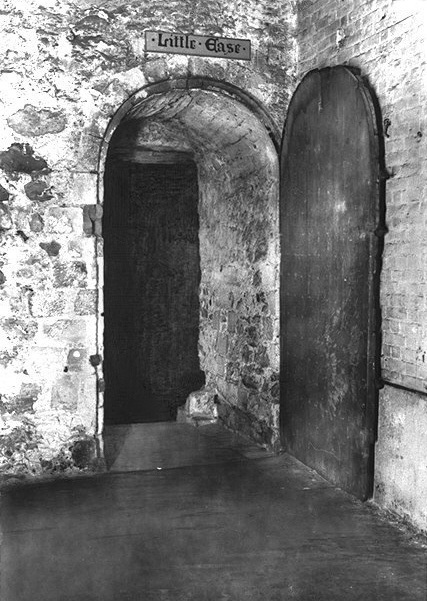Little Ease on:
[Wikipedia]
[Google]
[Amazon]
 Little Ease was a prison cell located beneath the White Tower in the
Little Ease was a prison cell located beneath the White Tower in the
 Little Ease was a prison cell located beneath the White Tower in the
Little Ease was a prison cell located beneath the White Tower in the Tower of London
The Tower of London, officially His Majesty's Royal Palace and Fortress of the Tower of London, is a historic citadel and castle on the north bank of the River Thames in central London, England. It lies within the London Borough of Tower Hamle ...
. The lightless cell was designed on a side, meaning that while an adult human could be placed inside, any occupant was prevented from being able to either stand, sit, or lie down, meaning it was impossible for him to find any physical position of rest (i.e., "little ease" could be found).
Evidence suggests that Edmund Campion
Edmund Campion, SJ (25 January 15401 December 1581) was an English Jesuit priest and martyr. While conducting an underground ministry in officially Anglican England, Campion was arrested by priest hunters. Convicted of high treason, he was ...
, a Catholic priest in Elizabethan England, was imprisoned for four days in the cell in July 1581. According to Bell (1921), by tradition, Guy Fawkes
Guy Fawkes (; 13 April 1570 – 31 January 1606), also known as Guido Fawkes while fighting for the Spanish, was a member of a group of provincial English Catholics involved in the failed Gunpowder Plot of 1605. He was born and educate ...
was housed there in 1605. Another possible inmate was Miles Prance
Miles Prance (''fl.'' 1678) was an English Roman Catholic craftsman who was caught up in and perjured himself during the Popish Plot and the resulting anti-Catholic hysteria in London during the reign of Charles II.
Life
Prance was born on the ...
in 1678. Bell also states that there is some doubt that the cell ever actually housed prisoners.
History
The Little Ease cell was a notorious form of confinement used in medieval times. It was a cramped and extremely uncomfortable prison cell that gained a reputation for its oppressive conditions. The cell was primarily used in the Tower of London, a historic castle located in London, England. The exact origin and construction of the Little Ease cell are uncertain, but it is believed to have been built during the medieval period, possibly in the 14th century. The Little Ease was specifically designed to be an uncomfortable and confining cell. It was incredibly small, usually measuring only about four feet in height and two feet in width. The prisoner was unable to stand up fully or lie down comfortably, as the cell's dimensions did not allow for much movement. The prisoner had to contort their body to fit into the cramped space. The purpose of the Little Ease cell was to induce extreme discomfort and physical suffering in the prisoner. It was primarily used for interrogation and the extraction of confessions. The cramped conditions and lack of space made it nearly impossible for the prisoner to rest or sleep. The discomfort, combined with the psychological pressure exerted by interrogators, was intended to break the prisoner's spirit and coerce a confession. Additionally, the Little Ease cell was deliberately located in a dark and isolated part of the Tower of London, further enhancing the psychological torment experienced by the prisoners. The lack of light and fresh air, along with the confined space, created an environment of sensory deprivation that could intensify the prisoner's mental distress. Although the Little Ease cell was infamous for its use in the Tower of London, similar forms of confinement existed in other medieval prisons across Europe. The conditions and dimensions of the cells might have varied slightly, but the general concept of a small, uncomfortable space remained the same. Over time, the use of the Little Ease cell declined, and it eventually fell out of use altogether.Other instances
Edmund Bonner
Edmund Bonner (also Boner; c. 15005 September 1569) was Bishop of London from 1539 to 1549 and again from 1553 to 1559. Initially an instrumental figure in the schism of Henry VIII from Rome, he was antagonised by the Protestant reforms introdu ...
, while Bishop of London
The bishop of London is the Ordinary (church officer), ordinary of the Church of England's Diocese of London in the Province of Canterbury. By custom the Bishop is also Dean of the Chapel Royal since 1723.
The diocese covers of 17 boroughs o ...
(1553–1570) maintained a little ease at St Paul's
St Paul's Cathedral, formally the Cathedral Church of St Paul the Apostle, is an Anglican cathedral in London, England, the seat of the Bishop of London. The cathedral serves as the mother church of the Diocese of London in the Church of Engl ...
. By day prisoners were displayed in stocks
Stocks are feet and hand restraining devices that were used as a form of corporal punishment and public humiliation. The use of stocks is seen as early as Ancient Greece, where they are described as being in use in Solon's law code. The law de ...
, by night kept in a coal house. In the 17th century a little ease in London's Guildhall
A guildhall, also known as a guild hall or guild house, is a historical building originally used for tax collecting by municipalities or merchants in Europe, with many surviving today in Great Britain and the Low Countries. These buildings commo ...
was maintained for the confinement of unruly apprentices.
References
Tower of London {{London-struct-stub